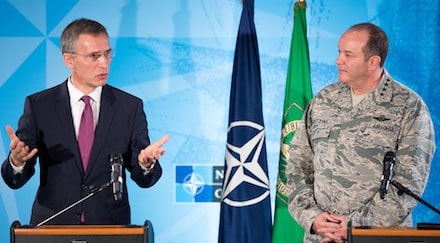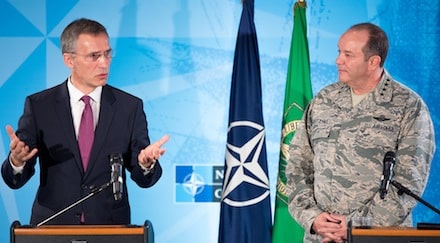
NATO Secretary General Jens Stoltenberg, a former prime minister of Norway, took the podium during last week’s meeting of NATO defense ministers to hype the Russian threat to NATO while downplaying recent NATO military moves on Russia’s border.
While criticizing “a more assertive Russia investing heavily in defence,” Stoltenberg countered that, “We do not seek confrontation [with Russia], and we do not want a new arms race.”
He then announced that the new enhanced NATO Response Force will triple in size to include 40,000 personnel instead of the originally announced 13,000 and that NATO would be setting up six new east European mini-headquarters in Bulgaria, Estonia, Latvia, Lithuania, Poland, and Romania.
A joint statement of the NATO defense ministers underscored Stoltenberg’s Russia points:
Russia is challenging Euro-Atlantic security through military action, coercion and intimidation of its neighbours. We continue to be concerned about Russia’s aggressive actions.
If NATO is to be taken at its word, these accusations should set off alarm bells. One would think that NATO member countries, faced with these “aggressive actions,” would be scrambling to ramp up their military spending to whatever is necessary to counter this military threat from Russia.
Yet strangely the opposite is happening. Despite the heated rhetoric coming from Stoltenberg and his spin factory, NATO HQ is having a difficult time getting its member states interested at all in the Russian threat. NATO member countries — particularly those most geographically vulnerable to the claimed Russian aggression — are not only not ramping up military spending, but in some cases are actually cutting their budgets.
Even the above defense ministers statement suggests frustration with this phenomenon:
We reaffirm the importance of the Defence Investment Pledge adopted at the Wales Summit. Accordingly, we are working on reversing the trend of declining funding for defence, and we will make the most effective use of our defence budgets.
Last year in Wales, NATO leaders pledged to reverse their declining military spending budgets. They have not done so.
The United Kingdom, one of Washington’s most bellicose partners when it comes to foreign interventionism, has infuriated US leadership by reducing rather than increasing its military spending. British Prime Minister David Cameron has apparently reneged on his country’s pledge to maintain military spending at 2% of GDP.
The response from London is to cook the books a little rather than actually increase spending. The Guardian reports that:
UK defence officials are now drawing up proposals whereby some foreign aid and intelligence services’ spending would be reclassified as ‘defence.’
En route to the NATO meeting, US Defense Secretary Ashton Carter did his best to goad the Germans into taking the Russian threat seriously. As Reuters reported:
Carter heads first to Berlin, where he is expected to call for a more muscular global security role from Germany, Europe’s largest economy. Germany remains hesitant to deploy troops abroad, seven decades after the end of World War II.
Germany, where defense spending decreased by 1.3% last year, is reportedly less than enthusiastic about contributing troops to the new 40,000 person NATO rapid reaction force to be placed on Russia’s border. Perhaps they have not forgotten history?
Even shrill Lithuania, which regularly claims that Russia is about to invade, cannot interest its citizens in signing up to fight for their country. The Baltic nation has been forced to re-introduce conscription to force Lithuanians to augment its miniscule 15,000 person armed forces. Lithuanian president Dalia Grybauskaitė, a former member of the Communist Party, said that without conscription there was “no other way to strengthen [the] army.” Lithuania spends about half of the NATO-required 2% of GDP on defense.
Enthusiasm over NATO’s demand for a tougher stand against Russia is even less among average European citizens than in the halls of power. Taken as a whole, not even 50% of NATO member country citizens would support their government responding with force should a NATO member country come under Russian attack. That means that the population does not support the very cornerstone of the NATO Charter, Article 5, which obligates a joint defense of any NATO member under attack.
Some 68 percent of those living in NATO member countries believe it will be the US who comes to their aid should Russia attack. They do not believe their own countries will do so.
Does this look like a Europe terrified by Russian aggression and facing an existential threat because of it? Would any government that truly believes it is about to be attacked by an aggressive foreign power actually reduce defense spending? Would any citizenry facing down invasion and occupation avoid military service like the plague?
Despite the endless propaganda of US and NATO officials about the Russian threat, it is clear that citizens and even their leaders do not believe it is real. There is a huge disconnect between the hyped threat and the real perceived threat. No wonder NATO is scrambling to set up new “information warfare” outposts throughout eastern Europe.

